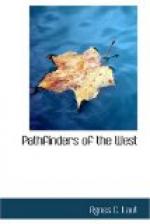The farther north they travelled the scanter became the growth of pine and poplar and willow. Snow still lay heavy in April; but Matonabbee ordered a halt while there was still large enough wood to construct dugouts to carry provisions down the river. The boats were built large and heavy in front, light behind. This was to resist the ice jam of Northern currents. The caribou hunt had brought other Indians to the Barren Lands. Matonabbee was joined by two hundred warriors. Though the tribes puffed the calumet of peace together, they drew their war hatchets when they saw the smoke of an alien tribe’s fire rise against the northern sky. A suspicion that he hardly dared to acknowledge flashed through Hearne’s mind. Eleven thousand beaver pelts were yearly brought down to the fort from the unknown river. How did the Chipewyans obtain these pelts from the Eskimo? What was the real reason of the Indian eagerness to conduct the white man to the “Far-Off-Metal River”? The white man was not taken into the confidence of the Indian council; but he could not fail to draw his own conclusions.
Scouts were sent cautiously forward to trail the path of the aliens who had lighted the far moss fire. Women and children were ordered to head about for a rendezvous southwest on Lake Athabasca. Carrying only the lightest supplies, the braves set out swiftly for the North on June 1. Mist and rain hung so heavily over the desolate moors that the travellers could not see twenty feet ahead. In places the rocks were glazed with ice and scored with runnels of water. Half the warriors here lost heart and turned back. The others led by Hearne and Matonabbee crossed the iced precipices on hands and knees, with gun stocks strapped to backs or held in teeth. On the 21st of June the sun did not set. Hearne had crossed the Arctic Circle. The sun hung on the southern horizon all night long. Henceforth the travellers marched without tents. During rain or snow storm, they took refuge under rocks or in caves. Provisions turned mouldy




